'THIS ONE’S REAL'
The Loafers Lodge fire
16.5.2023
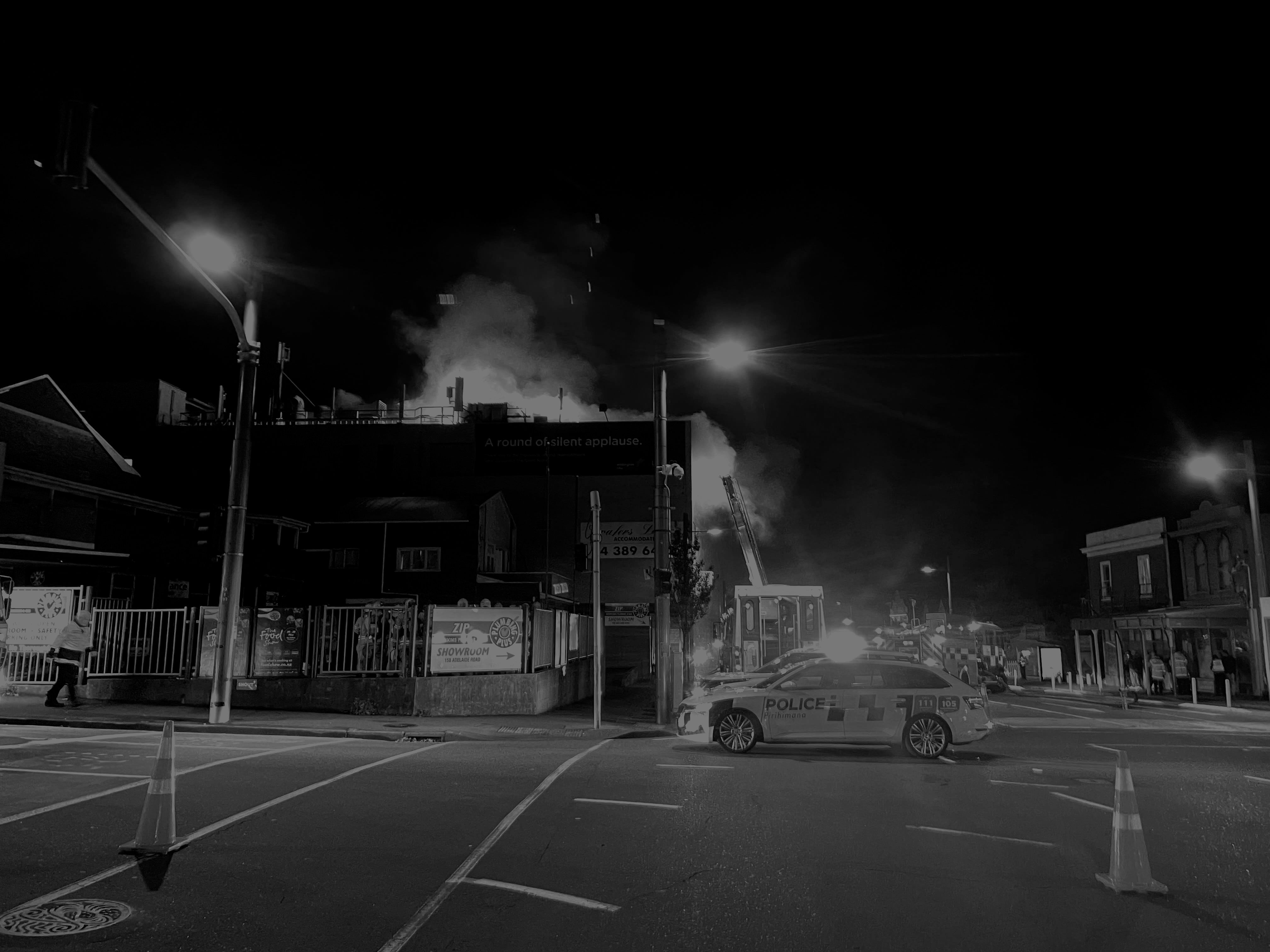
When the first siren went off, Simon Hannify figured it was like all the others he’d heard in his five months living at the Loafers Lodge. Just another false alarm.
“They go off all the time. Usually it’s a false alarm – somebody cooking toast or something,” he says.
A little while later - around midnight - it went off again.
“When I left my room, I could smell smoke in the hallway and so I went straight towards the kitchen and there was smoke like coming down the stairwell.”
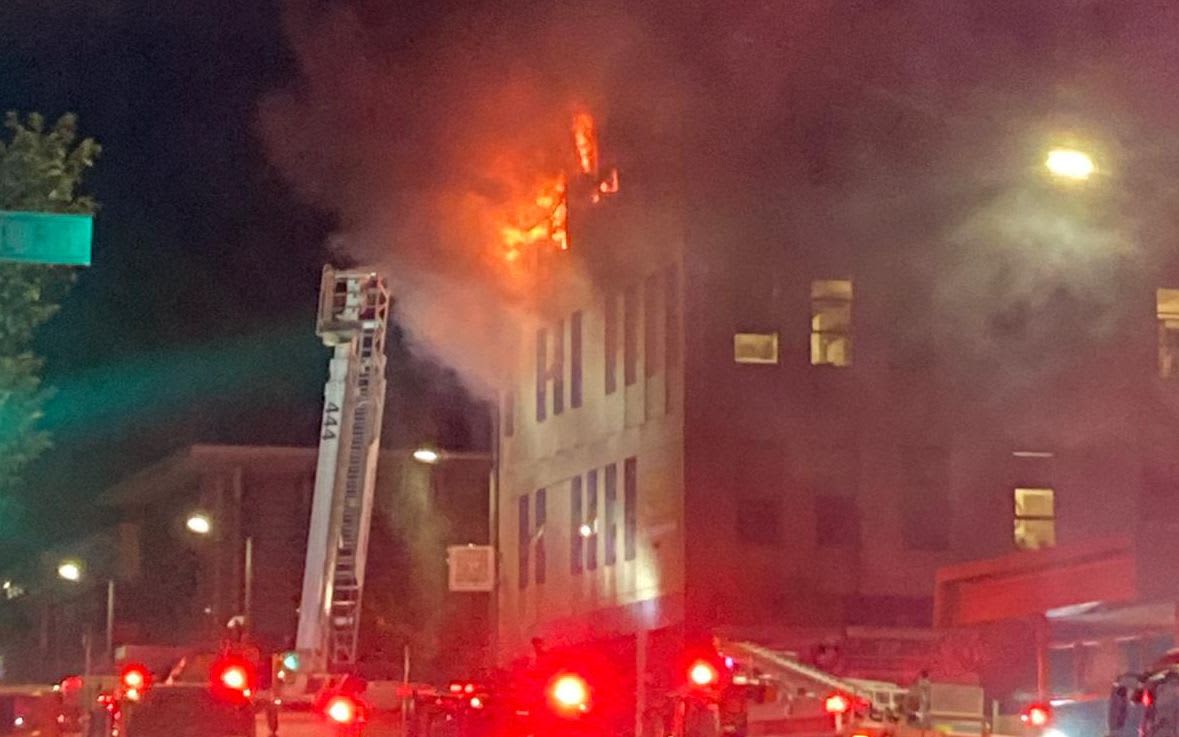
Flames roared from the top storey of Loafers Lodge early on the morning of Tuesday, 16 May. Photo: Supplied / Axel Dann
Flames roared from the top storey of Loafers Lodge early on the morning of Tuesday, 16 May. Photo: Supplied / Axel Dann
The Loafers Lodge hostel in the Wellington city suburb of Newtown was on fire. There were about 100 people inside. Everyone needed to get out.
“I sort of lapped around our floor knocking on doors saying: ‘Everyone out, this one’s real’,” Hannify says.
“Get out. There’s a fire. This one’s real.”
“It was scary. It was scary. But I knew I had to jump out of the window or just burn inside the building.”
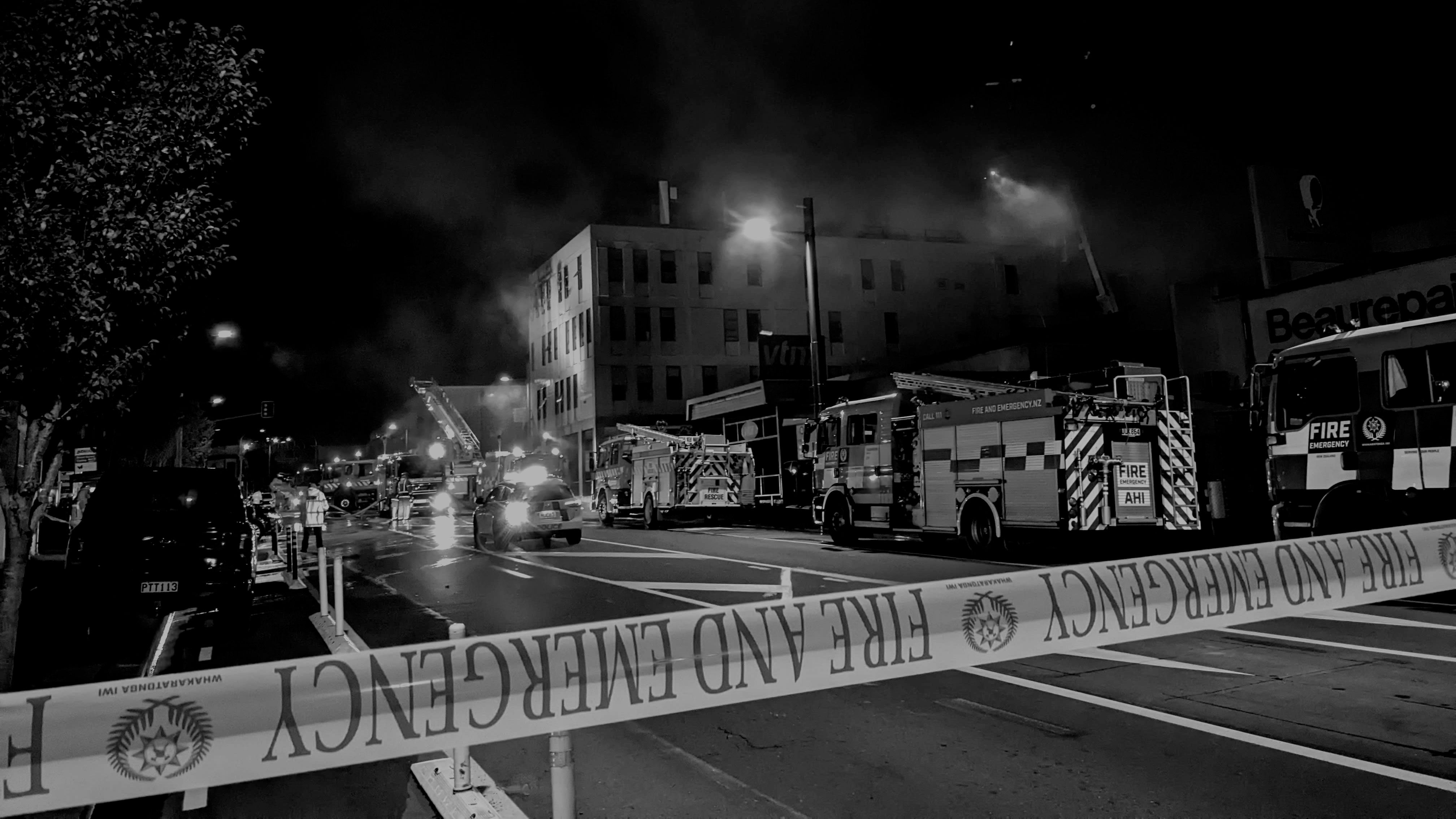
The flames were the most intense on the third floor. It seems likely that’s where the fire started.
Some on the third floor went up to the rooftop. Others scrambled down via the stairs.
Tala Sili went sideways.
"When I opened the door, the whole hallway was just dark and black with smoke,” he says.
“It smelt like poison.”
Through a window on the third floor, he could see the rooftop of a building next door. It was two stories down.
“It was scary. It was scary. But I knew I had to jump out of the window or just burn inside the building,” Sili says.
He sprained his ankle landing on the roof but got away from the fire otherwise physically unscathed.
Others remained stranded on the rooftop of the burning building.
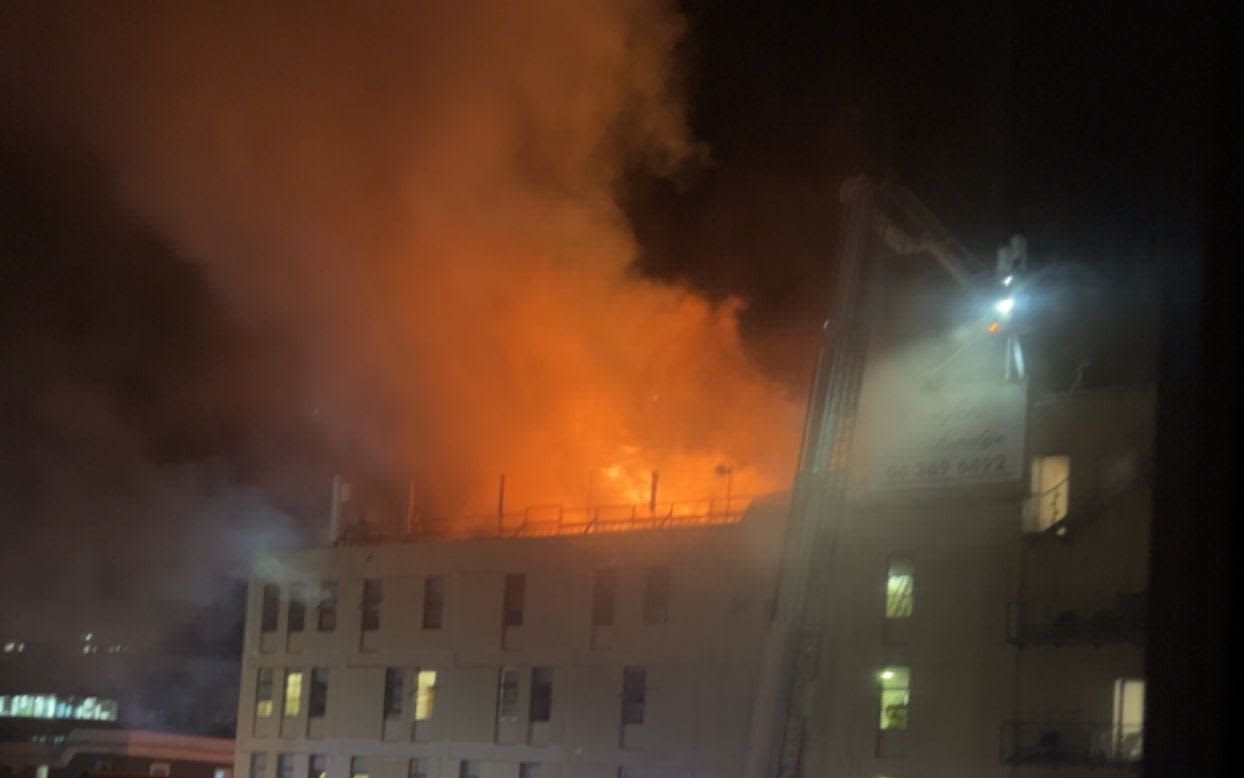
Flames and smoke billow from Loafers Lodge, on Adelaide Road, in Wellington. Photo: Supplied / Katelyn Paul
Flames and smoke billow from Loafers Lodge, on Adelaide Road, in Wellington. Photo: Supplied / Katelyn Paul
At around 2am, Charlotte Davenport and her partner opened the curtains of their nearby townhouse to the scene.
“We could see the fire crew on top of a ladder trying to put out the flames,” she told Stuff.
“We could hear the fire crew yelling out instructions.”
They were especially worried about those on the top floor.
“We were horrified. We walk past that lodge most days. We know elderly people live on that top floor where the fire was. We worried, would they be okay? They can’t get themselves down three floors.”
They were right to be concerned.
Hemi Jones opened the door of his third-floor room to thick smoke and flames licking the ceiling.
“The people next door to me were dying,” he says.
He fell to the floor and crawled down three flights of stairs.
The first firefighters on the scene met people in the stairwell screaming at them to save their mates up on the top floor.
Firefighter Clark Townsley was one of the first into the burning building.
"The crews did everything they could to make access to the building,” Townsley says. "We made good headway. Unfortunately, the fire conditions sort of pushed us back."
A young officer – as yet unidentified – directed the rescue of five people from the rooftop.
"Those people were going to perish except for the intervention of our team,” says Fire and Emergency (FENZ) deputy district commander Brendan Nally.
“The young officer that led that did an outstanding job. Multiple people are walking around because of it."
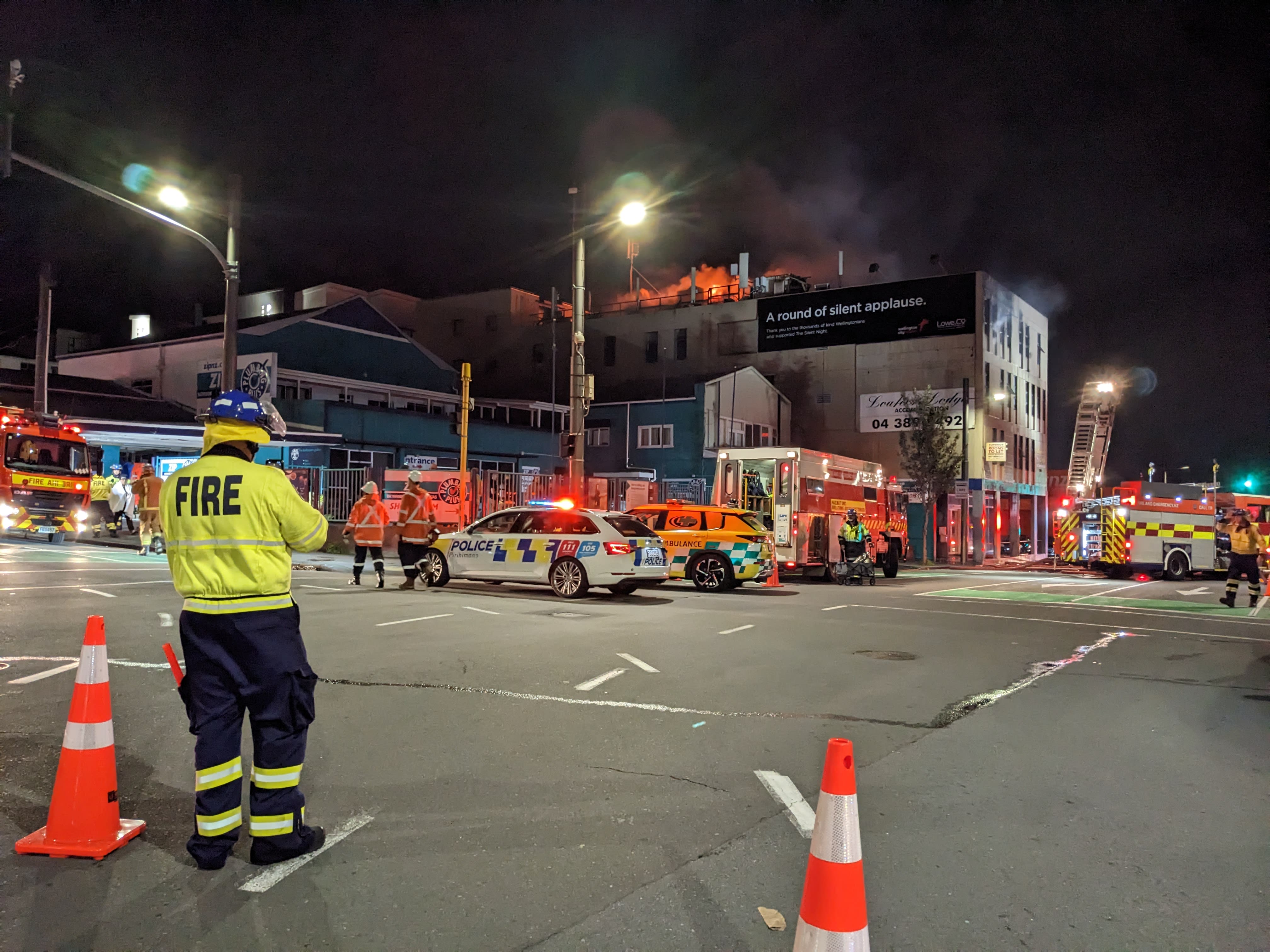
At the cordon of the fire early on Tuesday, 16 May. Photo: RNZ / Denise Garland
At the cordon of the fire early on Tuesday, 16 May. Photo: RNZ / Denise Garland
A 32-metre ladder truck with a basket on the end did the job. It got there nine minutes after a smaller truck, with a 17-metre ladder, arrived first. Firefighters expressed concern about the lack of a second, large truck, which was out for repairs. Was this decisive? FENZ chief executive Kerry Gregory has acknowledged firefighters did raise concerns and “had to adjust their tactics” based on the trucks available at the time.
Inside the building, firefighters hauled specialist equipment with them. But when they got to the top, multiple rooms were already on fire and it did not appear to be a survivable situation.
They could feel the heat of black smoke that reached from floor to ceiling. Without ventilation the smoke grew thicker until, it seems, part of the roof gave way and some of the smoke could escape.
Mark Jones, another who escaped the fire, says the fire had “a really, really bad smell to it - like some sort of chemical, or solvent.”
“What we didn’t realise at the time was how quickly the fire just went through the top floor. Rapidly, like it was an explosion almost,” Jones says.
While the fire burned on, a list of about 100 people who were thought to have been staying at the lodge overnight surfaced.
When Nally arrived at around 5am, a large number of the names on that list were still unaccounted for.
Wellington’s Mayor Tory Whanau was at the scene by about 6:15am.
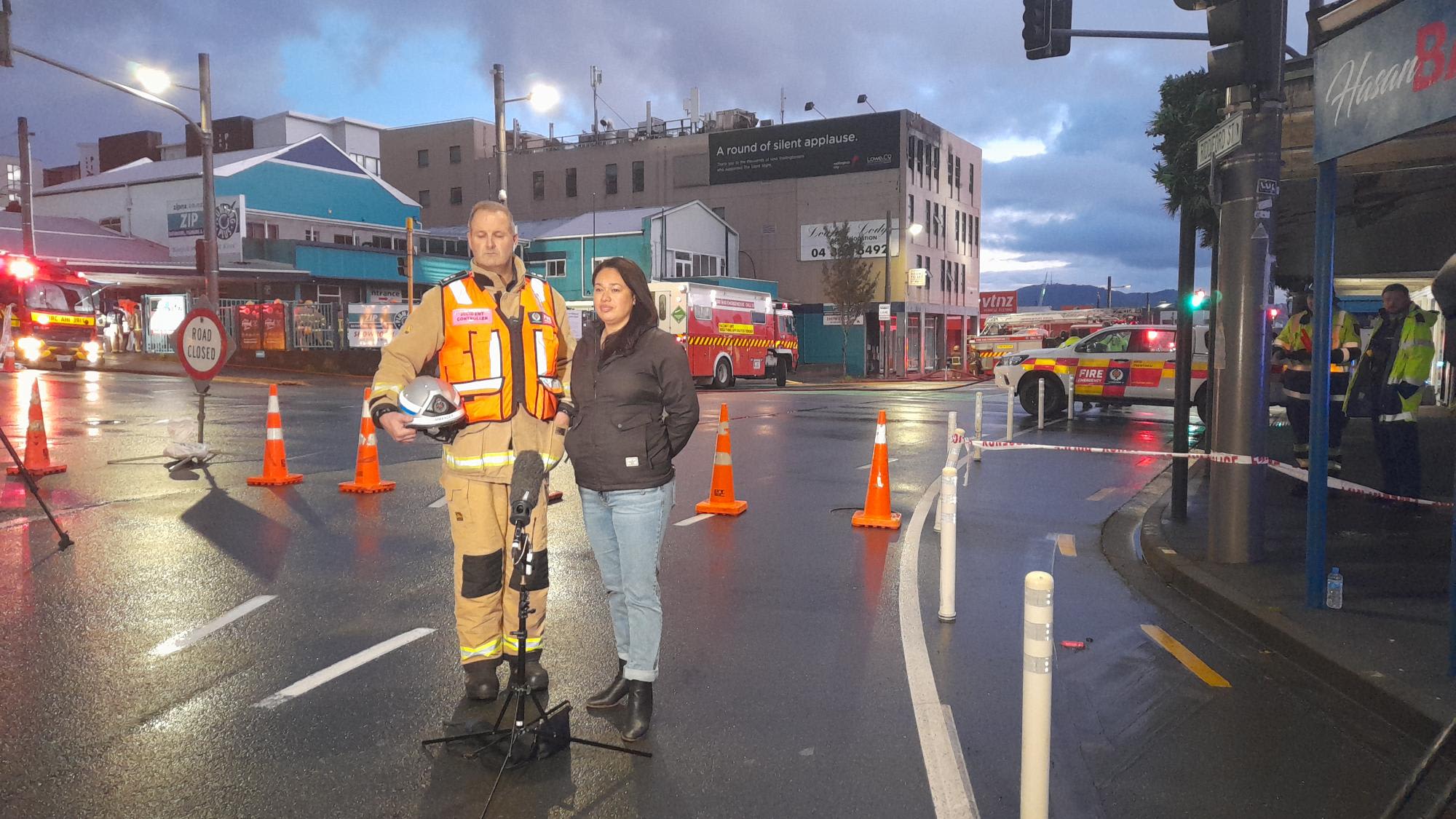
FENZ Wellington district manager Nick Pyatt, left, and Wellington Mayor Tory Whanau speak to media from the scene of the fire. Photo: RNZ / Jemima Huston
FENZ Wellington district manager Nick Pyatt, left, and Wellington Mayor Tory Whanau speak to media from the scene of the fire. Photo: RNZ / Jemima Huston
Reporters, including RNZ’s Jemima Huston, were there too. There were no flames by this point and ashes were being dampened.
Whanau and FENZ District Manager Nick Pyatt stood on the road at the intersection of Riddiford St and Adelaide Rd to speak to the media.
“The worst nightmare”

This was a “worst nightmare” scenario, Pyatt said.
On TVNZ’s Breakfast, an emotional Whanau called it "a strange situation to be in as the mayor".
"I'm feeling a lot of pain and emotion for those who have been lost and at this moment, we just have to get those who have made it out of the building … [to] feel safe. We have some in hospital at the moment with injuries. We have to deal with that as soon as possible.”
By now, the number unaccounted for had fallen to 11.
Prime Minister Chris Hipkins was the first to put a definitive number to a death toll. He said at least six people were dead. Neither FENZ nor police were keen to talk about a specific number, though they did say it would be “multiple” people dead and not more than 10.
Later in the afternoon, FENZ would confirm they knew of six dead bodies in the building.
THE AFTERMATH
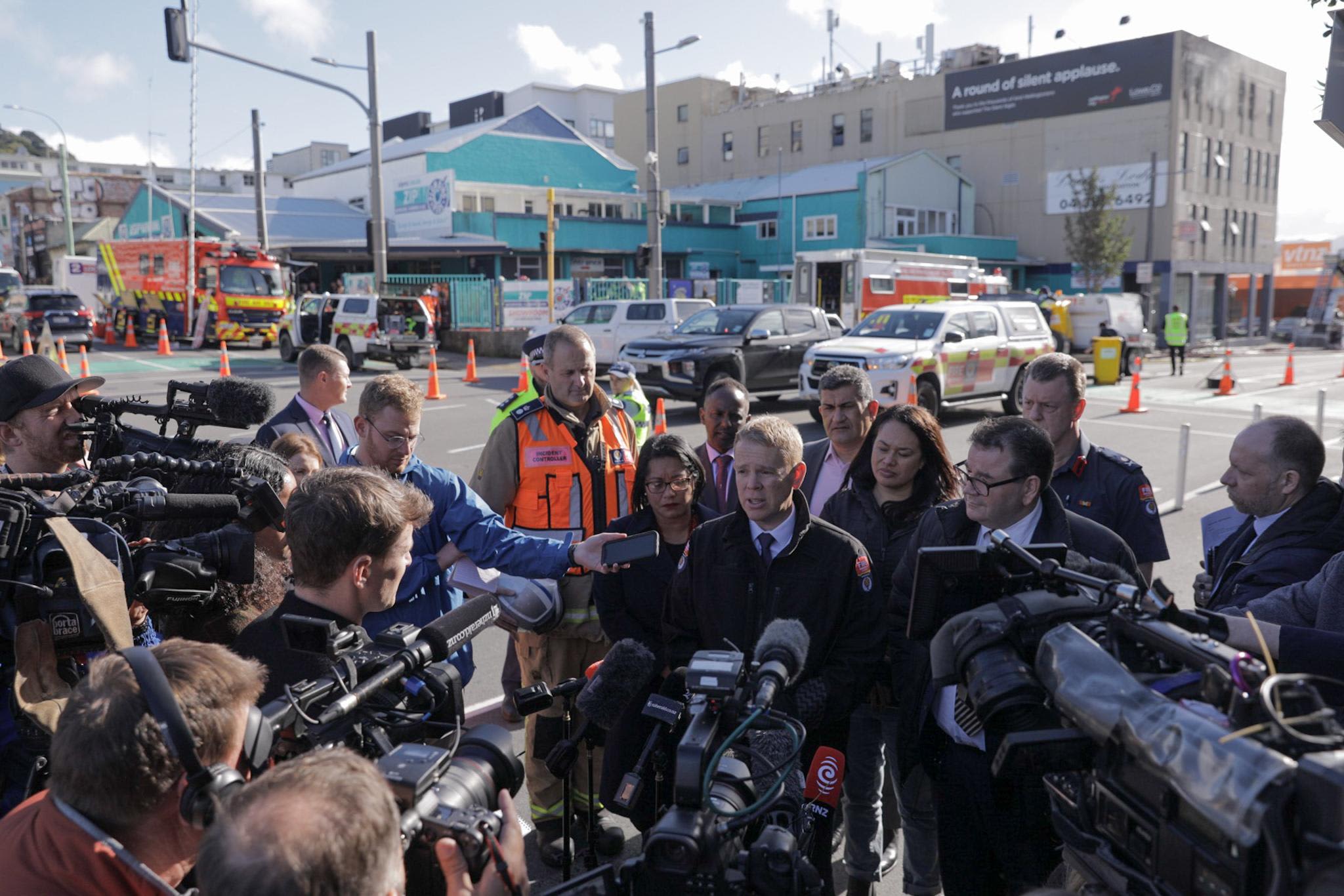
Prime Minister Chris Hipkins, flanked by central and local government colleagues, spoke with media at the scene of the fire on Tuesday morning, 16 May. Photo: RNZ / Angus Dreaver
Prime Minister Chris Hipkins, flanked by central and local government colleagues, spoke with media at the scene of the fire on Tuesday morning, 16 May. Photo: RNZ / Angus Dreaver
As the morning progressed, politicians filed through the scene.
National Party leader Christopher Luxon and his deputy Nicola Willis. Local MPs Paul Eagle and Grant Robertson, from Labour. Prime Minister Hipkins.
Australia’s PM Anthony Albanese phoned Hipkins to offer his nation’s condolences and support.
Drones were sent up over the building to analyse the damage.
By mid-afternoon, Wellington City Missioner Murray Edridge said everyone who needed accommodation for the night ahead, was organised for a bed.
Another press conference on the road outside the building happened at 4:30pm.
Chief Coroner Judge Anna Tutton said they couldn’t yet safely remove the bodies from the scene.
She warned the identification of bodies can be a pain-staking, slow and complex process, especially when people are severely injured.
In numerous similar cases overseas, the wrong body had been returned to a grieving family.
“We know that families will be desperate to have their loved ones back with them, but we have to get it right,” Tutton said.
At the same press conference, police acting Wellington district commander Inspector Dion Bennett said they did not believe the fire had been deliberately lit. He also said they needed a scene examination to be completed before they could say more about what they thought had happened.
It was around this time that more detailed information was emerging about who was in the building when it caught fire. It began to be blurred in with theories – and unsubstantiated rumours – about who and how the fire was started.
"These are people who have been through a lot of trauma and have been really displaced in this country and stuck in accommodation because they were vulnerable and had nowhere else to go"
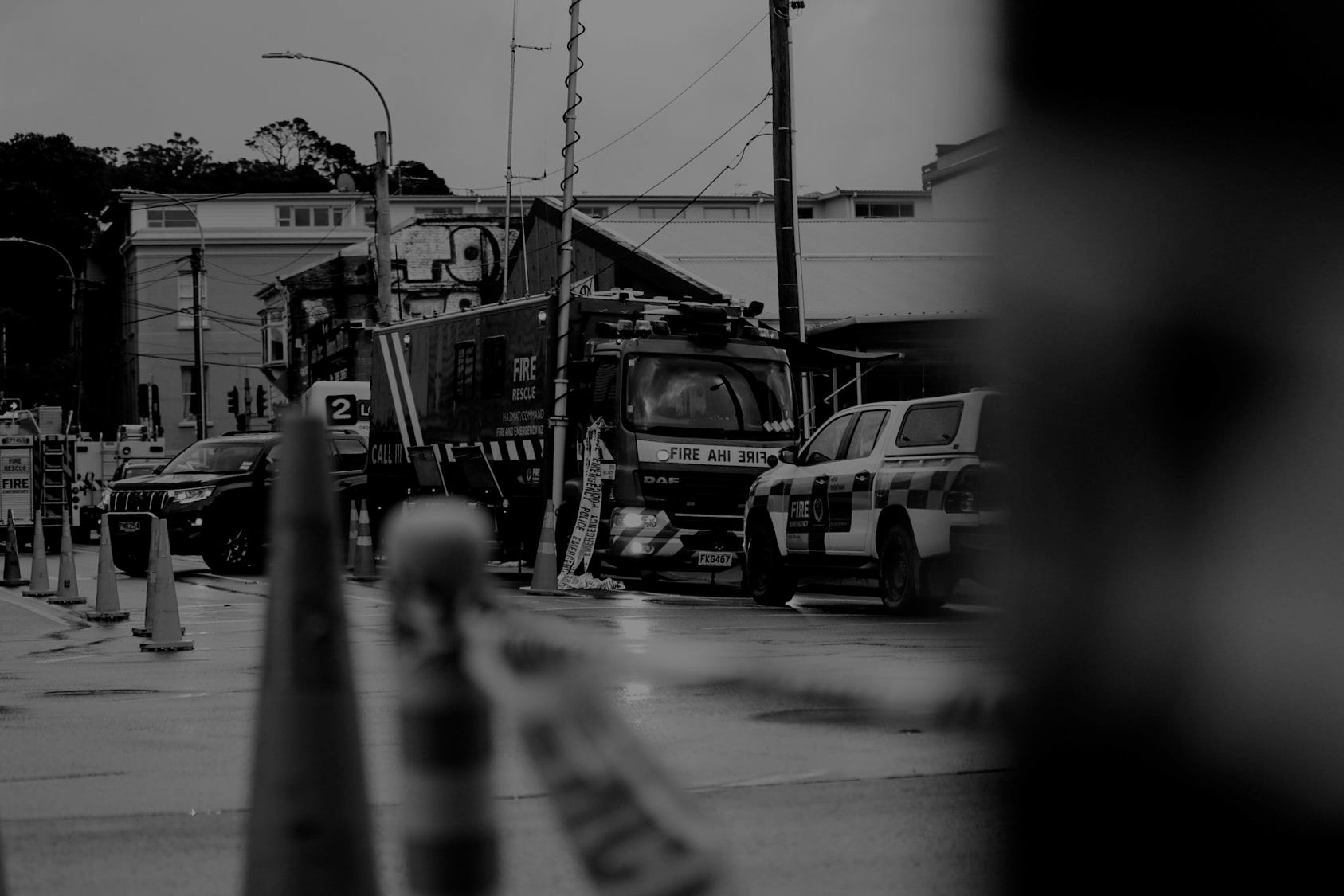
THE PEOPLE OF LOAFERS LODGE
The road outside Loafers Lodge was the venue for more press conferences on the day after the fire.
“Sir, can you confirm please that on the third floor they were mostly parolees?” an Australian reporter asked the Loafers Lodge director Greg Mein.
“Was it dedicated as a halfway house from prison?”
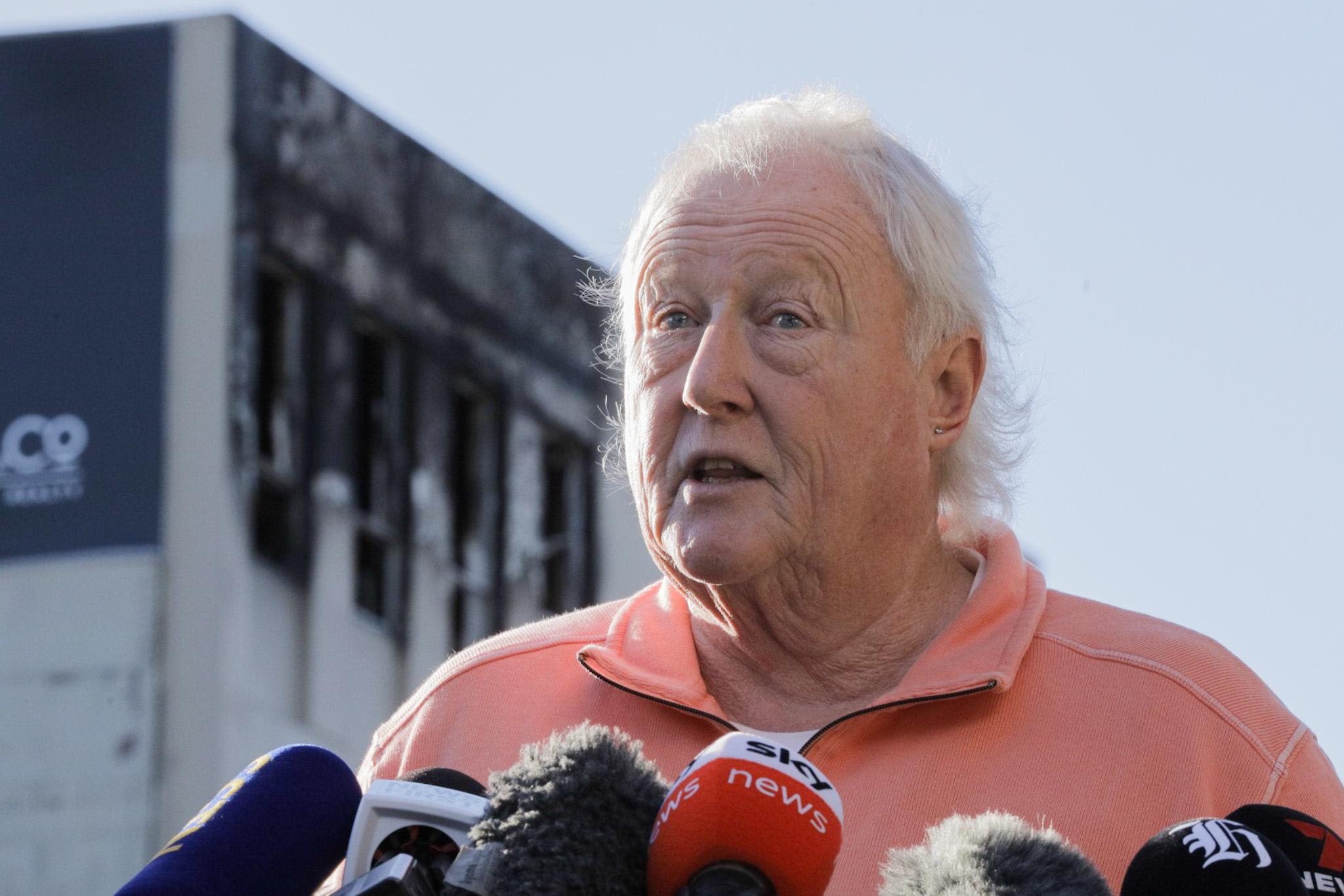
Loafers Lodge director Greg Mein speaks to media on Wednesday, 17 May. Photo: RNZ/ Angus Dreaver
Loafers Lodge director Greg Mein speaks to media on Wednesday, 17 May. Photo: RNZ/ Angus Dreaver
Mein said he was unable to answer the question – it was something the people involved in the day-to-day operations of the place would know. He was not one of them.
The question wasn’t as outrageous as it might have seemed.
On the day of the fire, Corrections confirmed that it had nine people on a community sentence or order living at Loafers Lodge. Two of the nine were unaccounted for.
Separately, an advocate for so-called ‘501 deportees’ from Australia confirmed some of them were in the building too. Not all of them were accounted for, either.
"These are people who have been through a lot of trauma and have been really displaced in this country and stuck in accommodation because they were vulnerable and had nowhere else to go,” advocate Filipa Payne said.
A convicted arsonist, Raymond Lauder, who was staying at the lodge says police interviewed him for several hours about the fire.
The 501s, paroled prisoners and ex-convicts shared the place with a variety of others.
For a while the Ministry of Social Development had used it for short-term, emergency housing, though this was not the case when the fire happened.
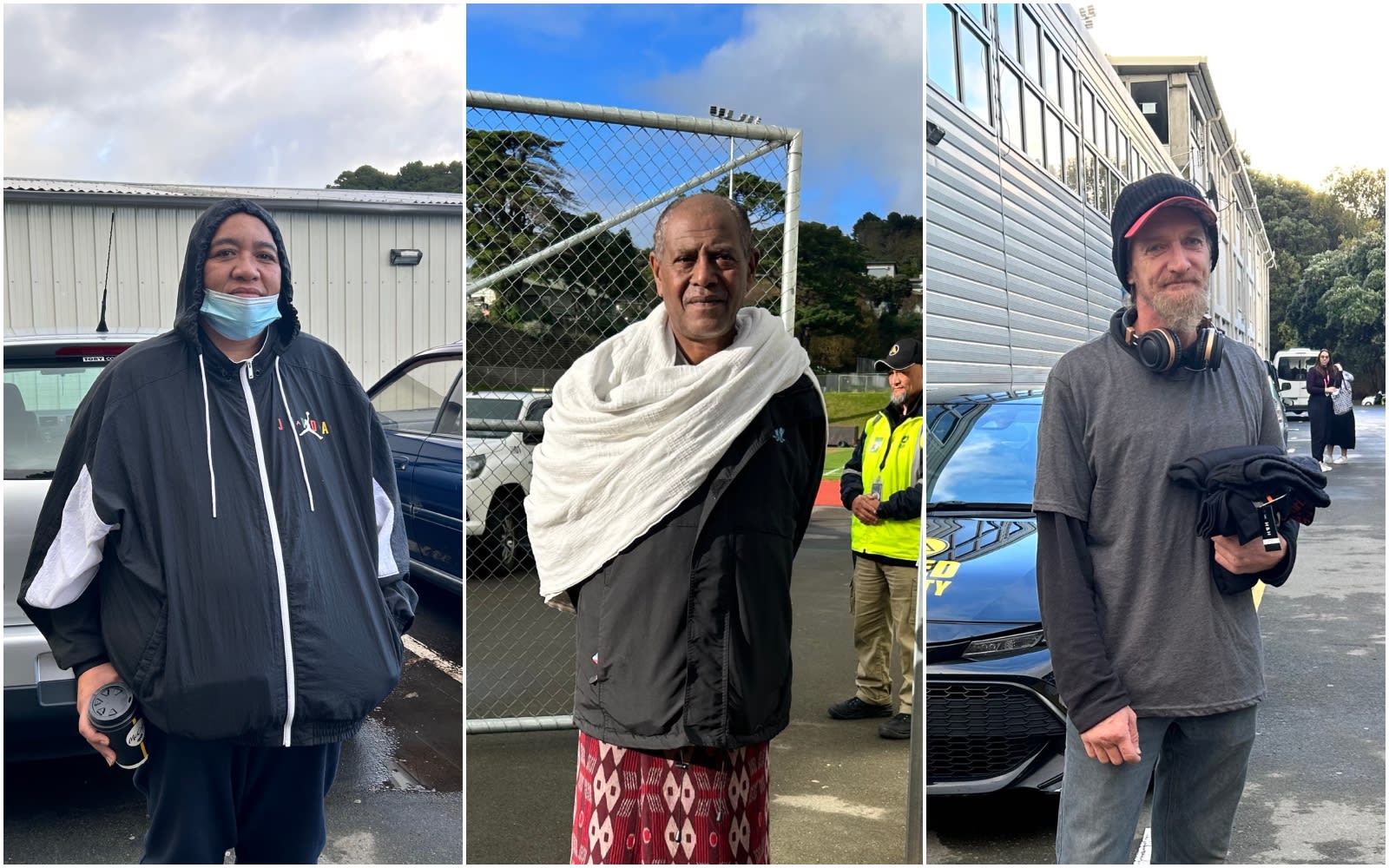
Some of the residents of Loafers Lodge who escaped the fire: Miimetua Cameron, Tamrat Isse Adan and Simon Hanify. Photo: RNZ / Ashleigh McCaull
Some of the residents of Loafers Lodge who escaped the fire: Miimetua Cameron, Tamrat Isse Adan and Simon Hanify. Photo: RNZ / Ashleigh McCaull
Still, Whanau described it as “more of a transient type of accommodation” with “a number of vulnerable people” staying there.
Its close proximity to the hospital helps explain why there were a number of migrant nurses and other medical staff staying there.
“We’ve got everyone living there. We have nurses. We’ve had doctors, nurses, unemployed people, meat workers, hospital staff. All sorts of people. A real variety of people.”

The hostel’s manager Marie Murphy told Stuff a range of people lived there.
“We’ve got everyone living there. We have nurses. We’ve had doctors, nurses, unemployed people, meat workers, hospital staff. All sorts of people. A real variety of people.”
The owner of a nearby florist said she’d met some of the most interesting people in her life from the hostel – people with "a wicked sense of humour”.
This was the more polite interpretation of the clientelle.
Mein, in his short and rather belligerent press conference, hinted at some guests spreading “all sorts of rumour and innuendo” about the fire because they had an axe to grind.
“We have 90-odd residents. There might be the odd disgruntled one there,” he said.
“We try and deal with everyone as best we can. They all have varying needs and we do the best we can.”
Some guests, or friends of guests, also seemed to be pointing to a combination of unsavoury clientele and rundown facilities when describing the place.
Lauder says he has spent more than a decade in prison and the lodge reminded him of it.
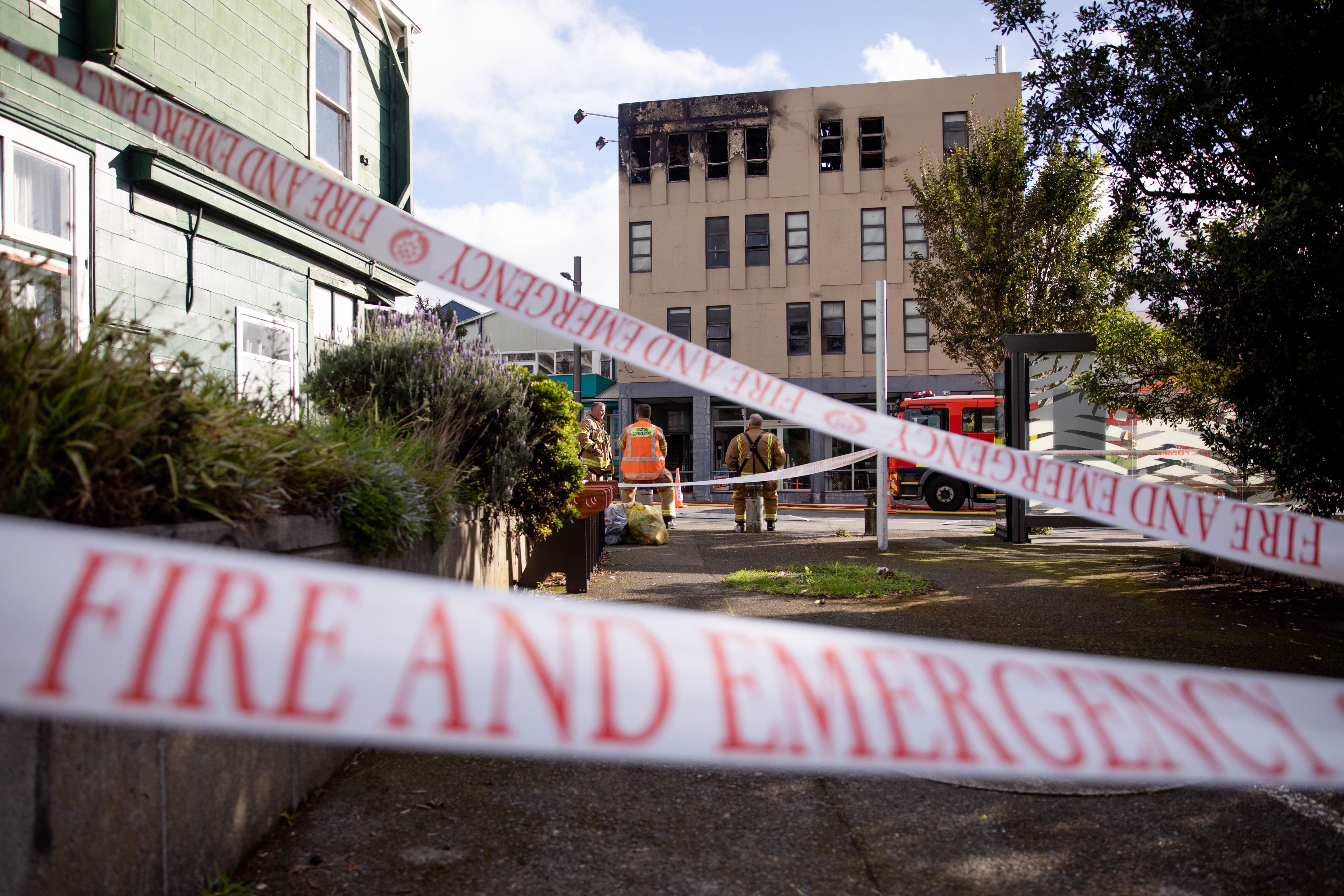
Loafers Lodge was home for about 100 people, many of whom were in difficult circumstances. Photo: RNZ / Angus Dreaver
Loafers Lodge was home for about 100 people, many of whom were in difficult circumstances. Photo: RNZ / Angus Dreaver
CCTV cameras caught thieves who would then be suddenly evicted, he says.
"They'd boot you out at any time and not give you your bond back. That's why I'm not surprised the place caught fire, someone had obviously had enough," Lauder says.
Doug Brown, who visited a friend at the hostel and was repeatedly telling him to move says: “It’s one of the worst places to be put in there. I wouldn’t recommend anyone stay there. It’s not the kind of place you’d want your kids or grandma or anyone living there."
“Seriously, I think some of those rooms were just cupboards. Like a storage cupboard. You go in and there’s no window."
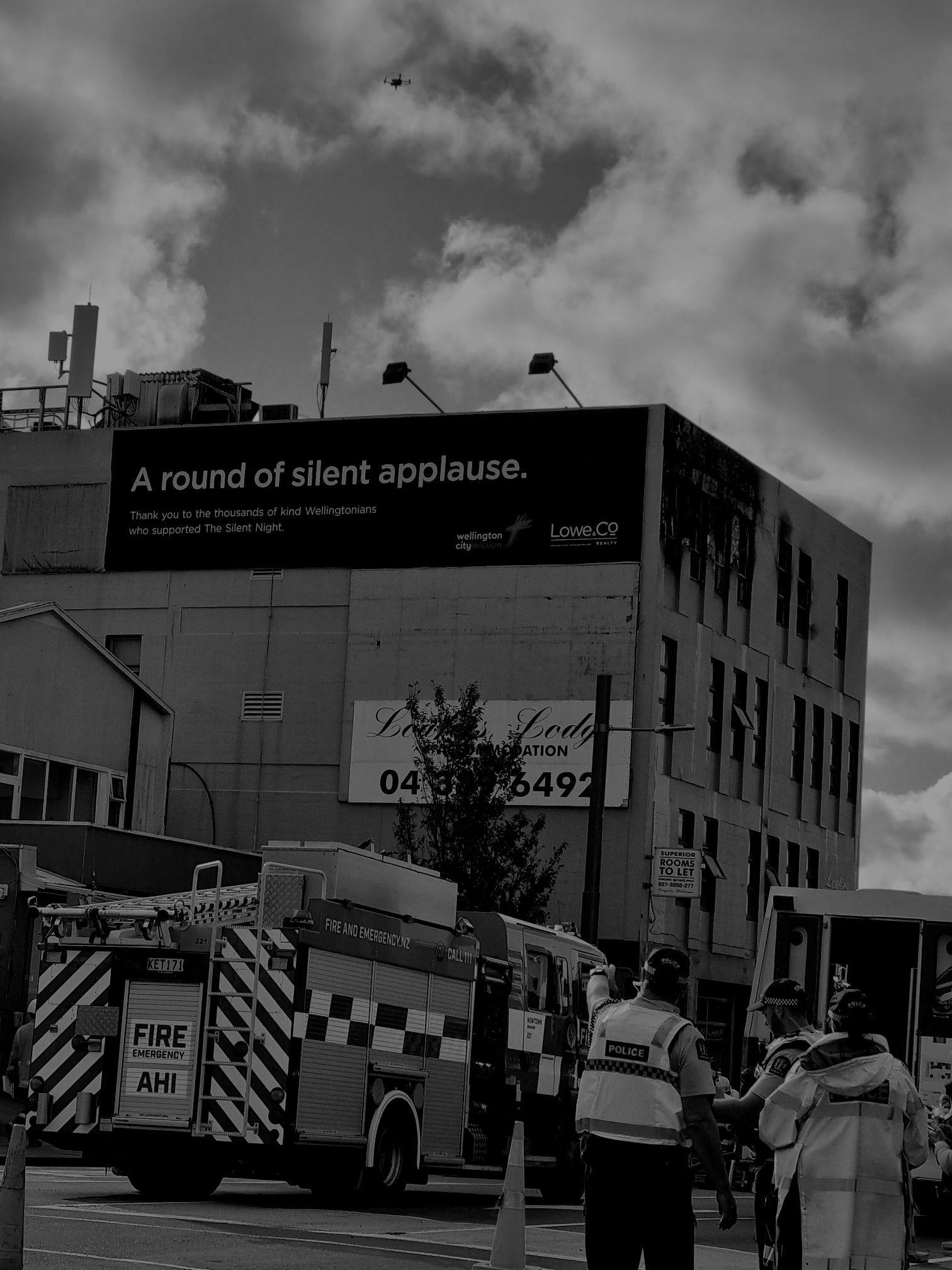
THE PROBLEMS WITH LOAFERS LODGE
Brown also complains about the size of the rooms at Loafers Lodge.
“Seriously, I think some of those rooms were just cupboards. Like a storage cupboard. You go in and there’s no window."
Others describe it as “a maze” inside.
There were no sprinklers. There was asbestos in the roof. There were frequent false alarms - many of the firefighters who battled the flames had been to the building before.
But still, after an inspection in February, it was issued a building “warrant of fitness” on 3 March this year.
In the aftermath, there were no immediately obvious reasons why, according to the rules, the building shouldn’t have got that warrant.
The questions now appear more likely to be focused on the adequacy of such a thing. Is the bar set too low for buildings such as this to be operating accommodation services?
Fire engineer Dr Geoff Thomas conducted a national study in 2014 that concluded short term residential housing is four times riskier for fire than houses.
Loafers Lodge wasn’t legally required to have sprinklers but Thomas says his study found low quality un-sprinklered hotels and backpacker accommodation have the highest fire fatality risk.
The day after the fire, Hipkins announced there would be a review of the building regulations for high density accommodation.
Around the same time, police announced they were treating the fire as suspicious.
Late on Thursday night, they announced a man had been charged with arson. The man appeared in court on Friday and was taken into custody.
A couple of hours later, police announced they had removed five bodies from the building. At that moment, the final death toll was still uncertain but it would be fewer than 10, they said.

Loafers Lodge resident Chris lays flowers near the building for the friends he lost in the fire. Photo: RNZ / Angus Dreaver
Loafers Lodge resident Chris lays flowers near the building for the friends he lost in the fire. Photo: RNZ / Angus Dreaver
Early on Wednesday morning, on that bit of the road outside Loafers Lodge that became an ad hoc stage for press conferences, a resident Chris was looking back up at the blackened windows of the third floor he’d escaped from little more than a day earlier.
“It’s quite emotional looking back up there because people lost their lives in a matter of minutes - and it was unnecessary,” he says.
“It’s emotional. It’s probably going to be an emotional couple of weeks, you know. I don’t even know - there's probably still bros that are still stuck up there that need to be removed.”
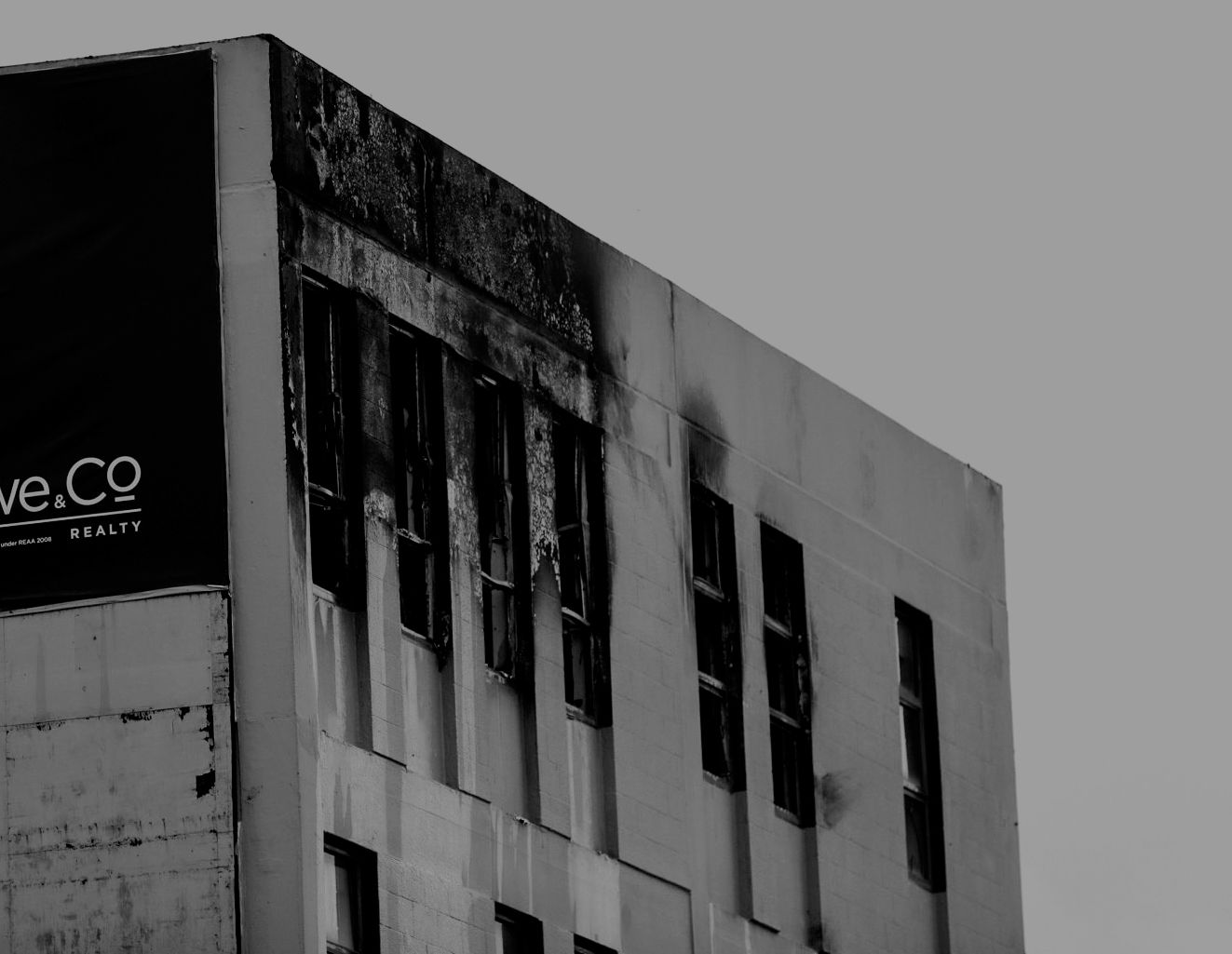
Credits
Based on reporting by the RNZ news team
Editor John Hartevelt
Layout and design RNZ


